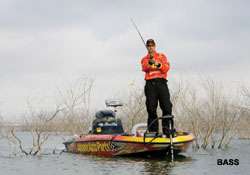
In the fall, the outdoor world seems to come alive, shaken free of the summer doldrums that zap all energy and enthusiasm. As the water temperature cools, every link of the bass' food chain becomes more active. One of the most common fond memories of any angler is casting around a cove where the surface of the water is electrified with frantic activity from baitfish and pursuing bass.
But, as with any season, an understanding of the fall movements of bass and the proper approach to taking advantage of that predictability will pave the way to consistent success. And when it comes to fall fishing, Marty Stone has mastered that routine.
The veteran North Carolina pro's autumn efforts concentrate on following the migration of bass into and out of shallow water. He attempts to pinpoint their location during the various stages of that movement and then allow the depth and cover being utilized at that time to dictate his choice of lure.
"Early in the fall, the biggest key to me is determining when the summer-to-fall movement started," Stone says.
"Several factors determine the initiation of this movement, with a good frost usually being the first. When you have the first big frost of the year, you'll usually have some kind of front directly afterward.
"This cools things down and makes fish feel good again. Then, you usually get a little shower providing fresh water in the backs of creeks and up in the river. Now you've got a double shot of life. To me, that's usually when you see the first big migration of fish, and they keep coming until it gets so cold that they have to go back out."
The two-time BASS winner emphasizes that following largemouth throughout the migration into and back out of shallow water is not easy because there aren't any definable steps or stopping points along the way.
"One day you can't get a bite in these areas and then it seems like overnight they just show up," he continues.
To intercept these migrating bass, Stone pays particular attention to riprap and chunk rock located in creeks (especially near the back), as well as around any channel swing. Laydowns, stumps and brush found in spots where the channel bends approach the shoreline also are prime locations this time of year.
"The fish will hold on almost-nothing cover," he adds. "The neat thing about this time of the year is when you hit a creek that's on fire, you can catch a fish out of a laydown and come back an hour later and catch another one. And come back an hour later and catch another one.
"I've also seen boat docks play a key role this time of year. If you have the right set of docks on a shallow flat in an area where everything's happening, you can time the bite when the shad move from the outside of the creek to the bank as the day progresses. It's a very, very visual way to fish."
Stone outlines his most productive techniques for ambushing the active bass of fall.
Spinnerbaiting. Small bladed baits are the ticket to plenty of action from October through early December. He uses a 1/4- or 3/8-ounce spinnerbait (white or chartreuse/white) with a gold No. 4 willow blade in the front and a silver No. 3 1/2 willow in the back (often weighted with a Lunker City Belly Weight). It is tied to 12- or 14-pound-test Bass Pro Shops XPS fluorocarbon.
Stone targets water with clarity of about 2 1/2 to 3 feet of visibility where he wakes a spinnerbait past isolated wood, rocks and sandbars. A second pattern early and late in the fall involves burning flat, clear water banks with little cover out on the main lake. With both patterns, he sometimes substitutes a small buzzbait on overcast, even rainy days when the bass are aggressive but tend not to hold tight to cover.
"I'm going to stay shallow because invariably all of our fall tournaments are won shallow somehow, some way," he says.
Flipping. Like spinnerbaits, the fall also calls for diminutive rubber-skirted jigs when flipping docks, brush and other shoreline cover. For Stone, that involves a 1/4- or 3/8-ounce Tru-Tungsten Jason Quinn Jig teamed with a small Zoom Salty Chunk trailer and 20-pound fluorocarbon line. His color choice is black/blue, green pumpkin or brown.
Cranking. "If it is a heavily pressured situation or if it's a deal where they're just not biting those two baits, then it's crankbait time," Stone advises. "But it's small crankbaits like a Lucky Craft (Fat CB) BDS 1 and 2.
"Remember, in the fall it's all about small baits. I'm cranking rock, wood, boat docks, anything in the back one-third of the creeks. Cover a lot of water and look for reaction bites."
His most productive colors are black/chartreuse and Tennessee Shad. The small crankbaits are tied to 10-pound-test fluorocarbon and fished on a 7-foot medium action American Rodsmiths Homer Humphreys Signature cranking rod.
Fall is the time when both bass and bass anglers come alive. And success is just a matter of making sure that the two meet regularly throughout the migration process.
Master Bait Movements
Bass seem more obsessed with baitfish, primarily shad, in the fall than in any other season. Find the baitfish and the bass will be nearby. It is that simple.
"The bait is everything — the bait and the life activity," Elite Series pro Marty Stone explains. "Bait might be in the backs of these creeks during the dog days of summer, but if there hasn't been a drastic cooling of the water, the bass will remain deep.
"Just remember when fishing in fall, if there's not baitfish in an area then you are wasting time there. You've got to be around the food because the food is the reason that the bass move shallow."




